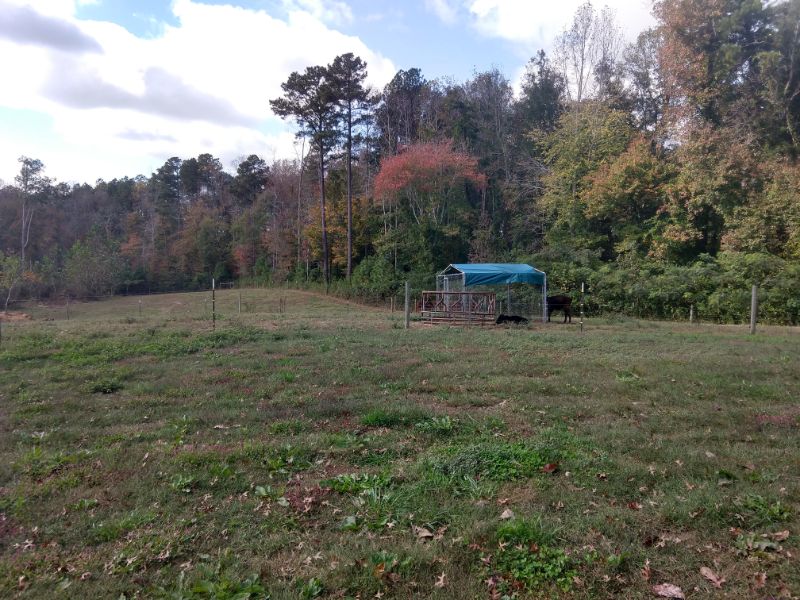|
|
 |
|||
|---|---|---|---|---|
| Home | Programs | Beliefs | ||
Sustainable Agriculture |
|
|---|---|
There is no precise definition for "sustainable agriculture". It can refer simply to farming practices that promote good soil and water conservation and maintain soil quality. At Woodcrest Farm, we take a more ambitious view. As much as possible, we want our farm to be a sustainable eco-system, where organic wastes produced by our livestock and poultry fertilize our crops; where we use no chemical fertilizers, herbicides, insecticides, or biosolids; no antibiotic feeds, no artificial growth hormones, no genetically modified seeds or livestock; and we take every opportunity to use renewable energy alternatives. Our motivation is two-fold. We do not believe the predominant agricultural practices can be sustained over the next 100 years without serious consequences for both our health and our food supplies. At Woodcrest Farm, we would like to promote agricultural practices that can be sustained without damaging our ecosystem and our own bodies. Moreover, our efforts to preserve as much of the cultural heritage of our area as we can necessarily includes sustainable agricultural methods because that is largely the agricultural of 100 years ago. In 1910, the family farm operated much as our does. Fields were fertilized with a horse-drawn manure spreader. Livestock were raised on pasture, poultry supplied eggs and insect control, and a variety of crops suitable for our locale provided seasonable produce that was either eaten in season or preserved. It is a far cry from our modern agri-business economy where crops are genetically engineered, planted in fields treated with herbicides, fertilized with chemicals either mined or synthesized, sprayed with toxic and often persistent insecticides (which tend to kill both beneficial and damaging insects), and machine-harvested. Once harvested, the crop must be washed, transported, packaged, and marketed, often thousands of miles from where it was grown. The energy requirements alone are unsustainable, to say nothing of the deleterious effects of non-organic additions to our soil and water. But the most pernicious consequence is that by evolving our eating habits towards what is cheap and easy to produce, we find that we are less and less healthy, and this is certainly not sustainable. |
|
Organic Farming |
|
All of our produce is raised in strict accordance with organic farming methods. All of our fertilizer is organic - chicken and livestock manure, to be specific. We control weeds through plastic and organic mulch, intensive cultivation, and hard work. We control insects by hand-removal, beneficial insects, row-covers, and as a last resort, using organic pesticides - primarily vegetable oil, soap, and naturally occurring bacteria. And we do fairly well. The photo above shows our crops in early June - healthy, lush, and soon to be very, very tasty. However, organic farming has its liabilities. As you can see, there are two rows in the center of the photo which were originally planted with squash varieties that fell prey to cutworms down to the last plant. These rows were re-planted with melons and covered, but our squash crop was almost non-existent (And I love summer squash). There is a running debate about whether organic food (and produce in particular) is really a healthier choice for our diets. We are not among those that believe that eating non-organic foods causes cancer, diabetes, heart disease, allergies, chronic fatigue, or any of the other diseases for which organic food is anecdotally given credit for curing. Having said that, we do firmly believe that the widespread use of herbicides, pesticides, chemical fertilizers, antibiotics, and hormones like BGH are implicated in many of these pathologies, and we are determined to find an alternative for ourselves and those who buy our products. So, we raise grass-fed rather than corn-fed beef. Our hogs are feed with soy and wheat grains and surplus produce. Our poultry is raised on the ground where they can find insects and minerals. By common testimony, our meat products are leaner and tastier than you can find in the grocery - they should be. They are what they eat. You can pick anything from our gardens and eat it on the spot if you want. No need to wash off insecticides or other poisons. We don't know if this will help you live longer, but it is certainly better for you. And us. |
|
Local Foods |
|
Since all of our sales are local, it is hardly a surprise that we heartily endorse and encourage the "Eating local foods". But, aside from our own self-interest, is there a benefit from you eating foods grown in the area where they are consumed? Most people visiting this site will have heard the familiar reasons:
Having reprised the standard arguments, our favorite reason for eating local foods is that you experience the full variety of seasonal crops to eat fresh or preserve for later in the year. Why learn to eat cabbage or rutabaga when you can import tomatoes and lettuce from Florida or Chile? But local crops, heritage recipies, and food preservation practices dating from when local food was the only option connect us to the land, the seasons, and the flavors that make eating an adventure that all too many of us ignore because a bland, uniform diet is more convenient. |
|
Heritage Breeds and Varieties |
|
Visit our farm and you will see a large variety of livestock, poultry, and (in season) produce, but you probably won't see many that represent the commercial breeds supplying the grocery stores. Our beef cattle are Dexters a small, hardy breed that flourished in the Irish and English highlands a century ago. Our dairy cattle are Jerseys, too small for commercial operations. Our goats are Alpines, our hogs are Tamworths, we have Dominque, Delaware, and Buckeye chickens, Katahdin sheep, and Halflinger horses. These are all heritage breeds, time tested, hardy, and useful on a small farm, but obsolete in the world of commercial agriculture. Why do we continue to raise them? Well, there is historical consistency, for one. But more important to us, is the desire to preserve a gene pool that is quickly becoming extinct. A century ago there were hundreds of cattle brands raised commercially. Today we use less than 10. |
|
GMO (Genetically Modified Organisms) |
|
The debate over GMO's seems to be argued more from a religious context than a unbiased evaluation of the pros and cons. At Woodcrest Farm, we do not experiment with genetically-modified livestock (rare), poultry (less rare), or plant GMO crops (fairly common). We do, however, use locally grown and milled cattle, poultry, and hog feed that is not certified organic and therefore can contain GMO grains. Our reservations about GMO's might seem silly when you realize that almost nothing humans eat these days is not genetically modified. The resemblance of modern wheat or corn to its wild ancestor is remote: it has been genetically modified by humans carefully selecting and breeding for desirable characteristics. So what is the problem in accelerating this process by inserting desirable genes into a plant or animal genome in the laboratory? One big objection is - time. It has taken 8000-10000 years at a minimum for humans to develop a wheat grain that combines high food value with favorable growing characteristics and resistance to plant diseases. During that time, we have had plenty of time to observe and assimilate the effects of the changes we have introduced, and the changes have had to be incremental, fairly small, and slow. In the GM world, change is instantaneous, precipitated (mostly) by the profit motive. Our bodies and our environment are not going to change - naturally, at least - at the same rate. An additional controversy revolves around whether GMO foods and additives should be labeled as such. Food producers, backed by the US Food and Drug Administration, say no, citing the cost of labeling and the potential alarm such labeling might provoke. Our position is that, whether or not you believe GMO foods are harmful or innocuous, consumers should be able to make an informed choice on what they are eating. As farmers, whether to use GMO varieties, particularly for animal feed, presents some hard choices. GMO crops are more resistant to disease and insect predation, which reduces the need for herbicides and pesticides. They have higher yields, which translate into profits which allow farms to be sustainable. And, significantly, GMO varieties of field corn and soybeans are so prevalent in the US that finding local sources for GMO-free feed is next to impossible. At Woodcrest, we have tried to make decisions that balance the best health, nutrition, and quality of our food products with our ability to sustainably produce them year after year.
|
|
